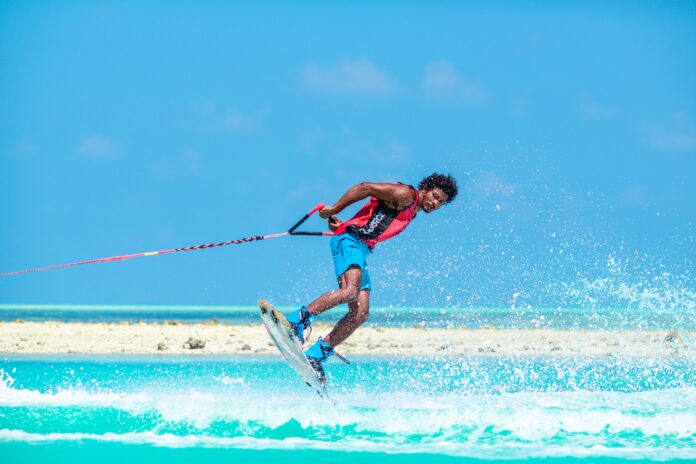In recent years, a thrilling water sport has taken the world by storm, captivating adventure seekers and water sports enthusiasts alike. Wing foiling, also known as wing surfing or simply winging, combines elements of windsurfing, kitesurfing, and stand-up paddleboarding to create a unique and exhilarating experience on the water. This emerging sport has gained significant popularity for its accessibility, versatility, and the freedom it offers to riders as they harness the power of the wind to glide across the waves. In this article, we delve into the world of wing foiling, exploring its origins, equipment, techniques, and the joy of riding the wind and waves in this exciting water sport.
Origins and Evolution:
Wing foiling traces its roots back to several water sports disciplines that have paved the way for its development. The sport’s origins can be attributed to the evolution of windsurfing and the introduction of stand-up paddleboarding (SUP) and kitesurfing. It was a natural progression as riders sought new ways to explore the water and harness the wind’s power. With advancements in technology and equipment, wing foiling emerged as a standalone sport that combined the best aspects of its predecessors.
Essential Equipment:
Wing foiling requires specific equipment designed to maximize the rider’s control and maneuverability on the water. The core component is the wing itself, which resembles a compact inflatable sail with a rigid leading edge and a series of handles or grips. The wing is held in the rider’s hands and acts as the primary source of propulsion, capturing the wind to generate power. The rider also uses a hydrofoil board, which features a hydrofoil attached to the bottom. This foil, often made of carbon fiber, lifts the board out of the water as speed increases, reducing drag and allowing the rider to glide smoothly above the surface.
Techniques and Riding Experience:
Mastering wing foiling requires a combination of skills from different water sports. Riders must understand the principles of windsurfing to harness the wind effectively and control the wing’s power. They must also adapt their stance and balance techniques from stand-up paddleboarding to maintain stability on the hydrofoil board. Additionally, kitesurfing experience comes into play when maneuvering the wing, using it to steer, generate lift, and execute aerial tricks.
The riding experience in wing foiling is a unique blend of freedom, speed, and connection with nature. As riders launch their wings and catch the wind, they experience an instant surge of power that propels them forward. The hydrofoil’s lift elevates the board above the water’s surface, providing a smooth and gliding sensation. The feeling of effortlessly riding the wind and waves, with the water rushing beneath, creates an exhilarating and adrenaline-filled experience like no other.
Versatility and Accessibility:
One of the key advantages of wing foiling is its versatility. Unlike some water sports that rely heavily on specific wind conditions or wave sizes, wing foiling can be enjoyed in a wide range of conditions. From calm lakes and rivers to open ocean swells, the sport allows riders to adapt and make the most of various environments. The wing’s lightweight and compact design also make it easy to transport, enabling riders to explore new locations and enjoy wing foiling wherever suitable conditions arise.
Moreover, wing foiling offers a relatively low barrier to entry, making it accessible to a broad range of individuals. Unlike traditional windsurfing or kitesurfing, which often require significant strength and skill, wing foiling can be learned and enjoyed by people of various ages and fitness levels. The learning curve is relatively quick, and with proper instruction and practice, beginners can experience the thrill of riding the wind in a relatively short period.
Safety and Precautions:
While wing foiling provides an exhilarating experience, it is essential to prioritize safety on the water. Like any water sport, understanding and respecting the elements is crucial. Riders should be mindful of wind conditions, familiarize themselves with local regulations, and always wear appropriate safety gear, such as a personal flotation device (PFD) and a helmet. Learning from experienced instructors and gradually building skills in controlled environments is also recommended to minimize risks and ensure a safe and enjoyable experience.
Conclusion:
Wing foiling has emerged as an exciting and accessible water sport, captivating enthusiasts with its unique blend of windsurfing, stand-up paddleboarding, and kitesurfing elements. With the ability to harness the wind’s power and glide effortlessly across the water’s surface, riders experience a thrilling connection with nature and a sense of freedom that is unmatched. As the sport continues to evolve and gain popularity, more individuals are discovering the joy and excitement of wing foiling. Whether seeking an adrenaline rush, a new way to explore waterways, or simply a fun and engaging outdoor activity, wing foiling offers an unforgettable experience for adventurers and water sports enthusiasts alike.
Wing Design:
Wing foiling relies on a specially designed wing that captures the wind and provides propulsion. The wings are typically inflatable and feature a rigid leading edge for stability and control.
Hydrofoil Board:
The hydrofoil board used in wing foiling features a hydrofoil underneath the board, which lifts the rider above the water’s surface as speed increases. This reduces drag and allows for a smooth and efficient glide.
Maneuverability:
Wing foiling offers excellent maneuverability, allowing riders to perform turns, carve through waves, and execute aerial tricks. The wing can be used to steer and control the direction of the board, providing a dynamic and responsive riding experience.
Versatility in Wind Conditions:
Wing foiling can be enjoyed in a wide range of wind conditions, from light breezes to stronger winds. The wings are designed to provide power and lift even in lighter winds, making the sport accessible to riders in various locations and weather conditions.
Accessibility:
Wing foiling is relatively easy to learn, making it accessible to beginners. With proper instruction and practice, individuals with different levels of fitness and water sports experience can quickly grasp the fundamentals and start enjoying the sport.
Portability:
The compact and lightweight nature of wing foiling equipment makes it highly portable. The inflatable wings can be easily deflated and packed, while the hydrofoil boards are typically designed for easy transportation. This allows riders to take their gear to different locations and explore new waterways.
Cross-training Benefits:
Wing foiling provides cross-training benefits for other water sports. Riders with windsurfing, kitesurfing, or stand-up paddleboarding experience can apply their skills and techniques to wing foiling, accelerating the learning process and enhancing their overall water sports abilities.
Adaptable to Various Water Conditions:
Wing foiling can be enjoyed in various water conditions, including lakes, rivers, and ocean swells. This adaptability allows riders to explore different environments and find suitable spots for their preferred riding style.
Fitness and Health Benefits:
Wing foiling is a physically engaging activity that offers fitness and health benefits. The sport involves core strength, balance, and cardiovascular endurance, as riders use their bodies to control the wing and maintain stability on the hydrofoil board. Regular wing foiling sessions can contribute to overall fitness and well-being.
Community and Events:
The growing popularity of wing foiling has led to the formation of a vibrant community of riders and enthusiasts. There are various events, competitions, and gatherings where wing foilers come together to share their passion, exchange tips and tricks, and celebrate the sport. This sense of community adds to the overall enjoyment and camaraderie associated with wing foiling.
Wing foiling has rapidly gained popularity as an exhilarating water sport that combines elements of windsurfing, kitesurfing, and stand-up paddleboarding. With its unique blend of wind-powered propulsion and hydrofoil technology, wing foiling offers an unparalleled riding experience that allows individuals to glide effortlessly across the water’s surface. In this article, we will explore the intricacies of wing foiling, from the equipment used to the techniques employed, and delve into the reasons behind its growing appeal among water sports enthusiasts.
At the core of wing foiling is the wing itself, which serves as the primary source of power. The wing features an inflatable structure with a rigid leading edge, providing stability and structure. It is designed to capture the wind, converting its energy into forward motion. The wing is held in the rider’s hands and manipulated to control speed, direction, and lift. The grip handles strategically positioned along the wing allow for easy maneuverability and adjustments while riding.
Complementing the wing is the hydrofoil board, a specially designed board equipped with a hydrofoil underneath. The hydrofoil consists of a mast and wings, which generate lift when the board gains speed. As the hydrofoil lifts the board out of the water, drag is significantly reduced, resulting in a smooth and efficient glide. The rider stands on the board and uses their body weight to maintain balance and control while riding atop the hydrofoil.
One of the key features that sets wing foiling apart from other water sports is its versatility in wind conditions. Unlike windsurfing or kitesurfing, which rely on strong winds, wing foiling can be enjoyed in a broader range of wind speeds. Even with lighter breezes, the wing’s design allows riders to generate power and maintain momentum, making it accessible to a wider range of enthusiasts. This adaptability to varying wind conditions contributes to the sport’s popularity, as it can be practiced in different locations and at different times of the year.
Another aspect that makes wing foiling attractive is its accessibility. While some water sports may require extensive training and experience, wing foiling can be learned relatively quickly, even by beginners. The learning curve is often less steep compared to other wind-powered sports, and with proper instruction and practice, individuals can experience the thrill of wing foiling in a short period. The simplicity of the equipment, along with its lightweight and portable nature, further contributes to the accessibility of the sport.
Wing foiling offers a unique blend of exhilaration and tranquility. Riders experience a sense of freedom as they harness the power of the wind, gliding effortlessly across the water’s surface. The feeling of being connected to nature, with the wind in their hair and the water beneath their feet, is a truly immersive and captivating experience. Whether cruising along calm waters or challenging themselves with aerial maneuvers and jumps, wing foilers can tailor their riding style to their preferences, making each session a personal adventure.
The sport of wing foiling also presents opportunities for cross-training and skill development. Riders with previous experience in windsurfing, kitesurfing, or stand-up paddleboarding can leverage their existing skills to accelerate their learning process. Familiar techniques such as board control, balance, and understanding wind dynamics can be applied to wing foiling, allowing enthusiasts to progress more quickly. This interconnectivity between water sports cultivates a sense of community and camaraderie among riders, who often come together to share their experiences and learn from one another.
In addition to the physical thrill, wing foiling offers numerous health and fitness benefits. The sport engages the entire body, requiring core strength, balance, and coordination. The constant adjustments and movements made to control the wing and maintain stability on the hydrofoil board provide a full-body workout. Wing foiling sessions can contribute to improved cardiovascular endurance, increased muscle tone, and enhanced proprioception. Furthermore, the sport encourages individuals to spend time outdoors, immersing themselves in nature and enjoying the beauty of their surroundings.
The rise of wing foiling has led to the formation of a vibrant community of riders and enthusiasts. Social media platforms, online forums, and local clubs provide avenues for individuals to connect, share tips and tricks, and organize meetups and events. The sense of community fosters a supportive environment where riders can learn from experienced individuals, seek advice, and celebrate their shared passion for the sport. Various competitions and exhibitions further fuel the growth of the wing foiling community, providing opportunities for riders to showcase their skills and inspire others.
As with any water sport, safety is of paramount importance in wing foiling. Riders should prioritize their well-being by adhering to safety guidelines and practicing proper precautions. This includes wearing appropriate safety gear, such as a personal flotation device (PFD) and a helmet, to protect against potential accidents. It is also important to be aware of local regulations, respect other water users, and maintain good etiquette on the water. As with any adventure sport, learning from experienced instructors and gradually building skills in controlled environments is recommended to minimize risks and ensure a safe and enjoyable experience.
In conclusion, wing foiling has emerged as an exciting and accessible water sport that captivates enthusiasts with its unique combination of wind-powered propulsion and hydrofoil technology. With its versatility in wind conditions, accessibility to beginners, and cross-training benefits for experienced riders, wing foiling offers a thrilling and immersive experience on the water. The sense of freedom, connection with nature, and health benefits associated with the sport make it an appealing choice for individuals seeking adventure, physical activity, and a new way to enjoy the beauty of the water. As the popularity of wing foiling continues to soar, it is expected to attract more enthusiasts and foster a dynamic and inclusive community of riders who share a passion for this exhilarating sport.


















